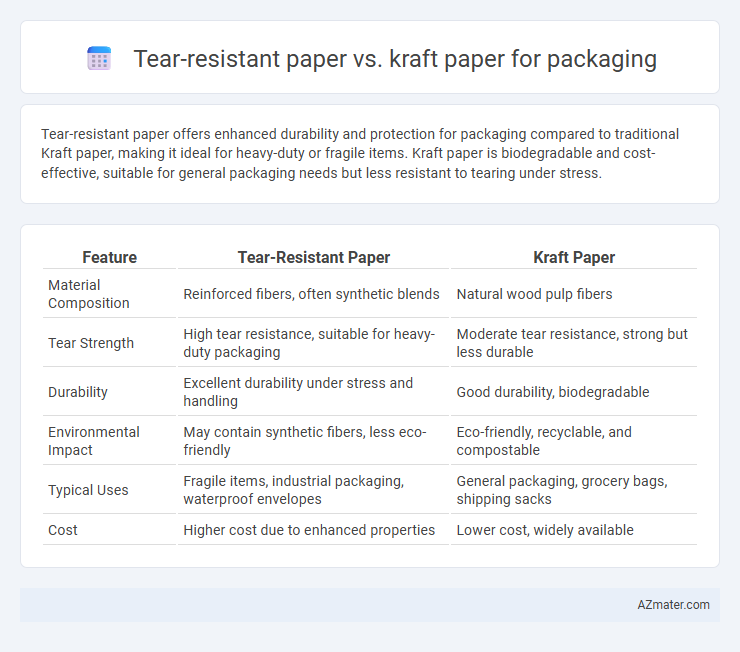Tear-resistant paper offers enhanced durability and protection for packaging compared to traditional Kraft paper, making it ideal for heavy-duty or fragile items. Kraft paper is biodegradable and cost-effective, suitable for general packaging needs but less resistant to tearing under stress.
Table of Comparison
| Feature | Tear-Resistant Paper | Kraft Paper |
|---|---|---|
| Material Composition | Reinforced fibers, often synthetic blends | Natural wood pulp fibers |
| Tear Strength | High tear resistance, suitable for heavy-duty packaging | Moderate tear resistance, strong but less durable |
| Durability | Excellent durability under stress and handling | Good durability, biodegradable |
| Environmental Impact | May contain synthetic fibers, less eco-friendly | Eco-friendly, recyclable, and compostable |
| Typical Uses | Fragile items, industrial packaging, waterproof envelopes | General packaging, grocery bags, shipping sacks |
| Cost | Higher cost due to enhanced properties | Lower cost, widely available |
Introduction to Tear-Resistant and Kraft Papers
Tear-resistant paper is engineered from high-quality fibers combined with synthetic materials to enhance durability and resist ripping, making it ideal for heavy-duty packaging applications. Kraft paper, derived from the kraft pulp process, boasts high tensile strength, natural brown color, and eco-friendly properties, frequently used for wrapping and cushioning in shipping. Both materials offer unique advantages in packaging, with tear-resistant paper excelling in protection against mechanical damage and kraft paper providing sustainable, cost-effective solutions.
Key Features of Tear-Resistant Paper
Tear-resistant paper offers superior durability with reinforced fibers that enhance resistance to ripping and puncturing, making it ideal for packaging heavy or sharp-edged items. This paper type typically features a higher tensile strength and improved tear propagation resistance compared to standard Kraft paper, ensuring reliable protection during shipping and handling. Its moisture resistance and longer lifespan contribute to maintaining package integrity under various environmental conditions.
Characteristics of Kraft Paper in Packaging
Kraft paper is known for its high tensile strength, durability, and resistance to tearing, making it an ideal material for packaging heavy or bulky items. Its natural brown color and eco-friendly properties contribute to sustainable packaging solutions, while its ability to be easily recycled enhances environmental benefits. Kraft paper's fibrous texture provides cushioning and protection during shipping, ensuring products remain secure and undamaged.
Strength and Durability Comparison
Tear-resistant paper offers enhanced strength with specialized fibers and coatings designed to prevent ripping under stress, making it ideal for packaging that requires durability against rough handling and sharp objects. Kraft paper, known for its high tensile strength derived from wood pulp fibers, provides excellent durability and resistance to punctures, frequently used in heavy-duty packaging and shipping applications. When comparing both, tear-resistant paper excels in flexibility and resistance to tears in thinner gauges, while kraft paper is preferred for its robust structural integrity and cost-effectiveness in bulk packaging solutions.
Cost Efficiency and Budget Considerations
Tear-resistant paper offers enhanced durability and protection for packaging sensitive or heavy items, often at a higher price point than Kraft paper, which is known for its cost-effective strength and environmental benefits. Kraft paper provides a budget-friendly option for standard packaging needs with reliable performance and recyclability, making it ideal for businesses prioritizing cost efficiency. Choosing between tear-resistant and Kraft paper depends on balancing protective requirements with financial constraints to optimize packaging investment.
Environmental Impact and Sustainability
Tear-resistant paper offers enhanced durability, reducing the need for double packaging and minimizing waste during shipping, which contributes to lower environmental impact. Kraft paper, made from natural wood fibers through a chemical pulping process, is biodegradable and recyclable, supporting sustainable packaging practices. Choosing between tear-resistant and Kraft paper depends on balancing strength requirements with eco-friendliness, where recycled or sustainably sourced Kraft paper often provides an optimal sustainable packaging solution.
Ideal Packaging Applications for Each Paper Type
Tear-resistant paper is ideal for packaging applications requiring enhanced durability and protection against punctures, making it suitable for shipping fragile or sharp-edged products. Kraft paper excels in heavy-duty wrapping and cushioning, commonly used for bulk packaging and eco-friendly bags due to its high tensile strength and recyclability. Selecting between tear-resistant and Kraft paper depends on the specific needs of product protection, with tear-resistant paper favored for rugged handling and Kraft paper preferred for sustainable, heavy-load packaging.
Printability and Customization Options
Tear-resistant paper offers superior durability and smooth surface quality, making it highly suitable for high-resolution printing and vibrant color reproduction, while kraft paper provides a more rustic, natural look with moderate printability on its coarse texture. Customization options for tear-resistant paper include glossy or matte finishes and compatibility with various ink types, enabling detailed branding and complex designs. Kraft paper, often used for eco-friendly packaging, supports simpler print techniques like flexographic or letterpress, appealing to brands emphasizing sustainability and minimalistic aesthetics.
Market Trends and User Preferences
Tear-resistant paper exhibits rising demand in packaging markets due to its enhanced durability, especially for heavy-duty and reusable applications, contrasting with kraft paper's traditional use in eco-friendly and cost-effective packaging solutions. Market trends highlight a growing consumer preference for sustainable and robust materials, leading to innovations that blend tear resistance with recyclability. Packaging manufacturers increasingly favor tear-resistant paper for premium goods, while kraft paper remains dominant in bulk shipping and organic product packaging sectors.
Choosing the Right Paper for Your Packaging Needs
Tear-resistant paper provides enhanced durability and protection for packaging fragile or heavy items, making it ideal for products requiring extra strength and longevity. Kraft paper, known for its natural brown color and eco-friendly properties, offers excellent versatility and cost-effectiveness for general packaging needs. Selecting the right paper depends on factors such as product weight, handling conditions, environmental impact, and budget constraints to ensure optimal protection and sustainability.

Infographic: Tear-resistant paper vs Kraft paper for Packaging
 azmater.com
azmater.com